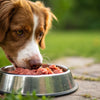Should My Dog Eat Raw Food? A Comprehensive Guide to Raw Diets for Dogs
- Houndsy
Table of Contents
- Introduction
- What Is a Raw Food Diet for Dogs?
- Nutritional Considerations in Raw Diets
- Health Benefits Associated with Raw Diets
- Risks and Concerns of Raw Feeding
- Finding the Right Balance: Do's and Don'ts
- Current Trends in Dog Nutrition
- Conclusion
- FAQs
Introduction
Did you know that nearly 15-25% of dog owners are now feeding their pets some form of raw diet? As pet parents, we constantly seek the best for our furry companions, which brings us to a pressing question: should my dog eat raw food? With the rise of raw feeding trends, this inquiry is more relevant than ever. This blog post aims to provide an in-depth exploration of the raw food diet for dogs—its pros, cons, safety concerns, and what a well-balanced diet looks like, helping you make informed choices for your beloved pet.
As we delve into this topic, we'll discuss the historical context of raw food diets, their nutritional implications, and the potential health risks involved. If you're considering making adjustments to your dog’s diet, we invite you to reflect on your current feeding practices as we guide you through essential insights. By the end of this article, you will better understand whether a raw food diet is appropriate for your dog and how to implement it safely if you decide to go down that path.
What Is a Raw Food Diet for Dogs?
A raw food diet (often referred to as RMBD—Raw Meat-Based Diet) includes a variety of ingredients typically composed of uncooked muscle meats, organs, bones, raw eggs, and dog-friendly fruits and vegetables. Supporters of this diet argue that it mimics what ancestral canines consumed, potentially providing health benefits ranging from improved coat quality to better digestion and dental health.
However, it is crucial to note that not all raw food diets are created equal. Common variations of raw food diets include:
- BARF Diet (Biologically Appropriate Raw Food): A popular model advocating for a specific ratio of meat, bones, and vegetables. For example, a typical BARF ratio might involve 70% muscle meat, 10% bones, and 20% plant matter.
- Prey Model Raw (PMR): This model focuses on replicating the prey consumption of wild canines, emphasizing the inclusion of whole animals.
Understanding these models provides a foundation for assessing whether a raw food diet aligns with your dog’s nutritional requirements.
Nutritional Considerations in Raw Diets
One of the primary arguments for raw feeding revolves around nutritional adequacy. A dog’s diet must be nutritionally complete and balanced, which means it should contain all the essential nutrients dogs need to thrive.
Essential Nutrients Dogs Require
- Proteins: Vital for muscle development and repair. Raw diets often boast high protein content, primarily from meat sources.
- Fats: Essential for energy and skin health, particularly omega-3 and omega-6 fatty acids.
- Carbohydrates: While not strictly necessary, they provide energy and aid digestion. However, many raw diets feature low carbohydrate content, usually under 10%.
- Vitamins & Minerals: These are crucial for overall health and immune function. A raw food diet may lack specific vitamins and minerals unless carefully formulated.
Potential Nutritional Shortfalls
Many commercial and homemade raw diets lack comprehensive nutritional balance. For instance, certain diets may not provide adequate calcium or vitamin E, leading to deficiencies over time. It’s essential to consult with veterinarians or pet nutritionists when formulating homemade diet plans to ensure the right balance of nutrients.
Health Benefits Associated with Raw Diets
Discussing the potential health benefits of raw feeding often stirs up passionate debate within the pet community. Here are some reported advantages that dog owners have noted when shifting to a raw food diet:
1. Improved Skin and Coat
Many advocates suggest that raw diets lead to shinier and healthier coats due to higher fat content and avoidance of fillers often found in processed foods. This can help improve skin hydration and overall appearance.
2. Better Digestive Health
Raw diets’ high moisture content and natural fibers can support healthy digestion and contribute to firmer stools. This is a crucial factor, especially for dogs that struggle with gastrointestinal sensitivity.
3. Dental Health Benefits
Chewing raw meaty bones can assist in reducing plaque and tartar buildup, promoting better dental hygiene naturally. Many owners have reported fresher breath and healthier gums in dogs consuming raw diets.
4. Enhanced Energy Levels
Pet owners often mention increased energy and vitality in dogs following a raw food regimen. While this can be attributed to cleaner ingredients and balanced nutrition, it’s essential to monitor your dog’s energy needs based on their age and activity level.
Risks and Concerns of Raw Feeding
While raw feeding has its supporters, it is not without risks. Here are some potential concerns linked to feeding dogs raw diets:
1. Bacterial Contamination
One of the most significant risks associated with raw diets is exposure to harmful bacteria such as Salmonella and E. coli. According to the CDC, untreated raw meats can pose health risks for both the dog and humans in the household. Special care must be taken during preparation and handling to avoid cross-contamination.
2. Nutritional Deficiencies
As previously noted, ensuring a balanced diet is essential. Many raw diets are not formulated with the complete nutritional profile required for dogs. Long-term feeding of inadequately balanced diets can lead to deficiencies, especially in vitamins and minerals.
3. Risk of Bone Fragments
Feeding dogs whole bones, whether raw or cooked, poses a hazard due to the possibility of fractures, splintering, or blockages in the gastrointestinal tract. This can lead to serious health complications requiring surgical intervention.
4. Allergies and Sensitivities
While some dog owners report improvements in allergies on raw diets, others may experience adverse reactions depending on protein sources. It is essential to monitor your dog’s reaction when introducing new foods.
Finding the Right Balance: Do's and Don'ts
If you’re contemplating incorporating some raw food into your dog's diet, here are some essential do’s and don’ts to guide your decision:
Do's
- Consult Your Veterinarian: Before making any significant changes to your pet’s diet, discuss your plans with your veterinarian.
- Start Slowly: Introduce raw foods gradually to your dog’s existing diet.
- Monitor Health Changes: Observe your dog for any behavioral or physical changes after introducing raw meals.
- Opt for Quality Ingredients: If considering commercially prepared raw diets, select those that are AAFCO-approved with a complete nutritional profile.
Don'ts
- Don’t Rush the Transition: Shifting too quickly can upset your dog’s digestive system.
- Avoid Incomplete Diets: Raw diets should not substitute a complete and balanced kibble diet unless formulated correctly.
- Don’t Feed Bones Without Caution: Avoid giving cooked bones or hard bones that can splinter, leading to injuries.
Current Trends in Dog Nutrition
As dog owners become more conscious of nutrition, several alternative dog feeding models have emerged to cater to diverse preferences:
- Fresh Prepared Meals: Pet food companies now offer freshly prepared meals that retain nutritional integrity without sacrificing quality.
- Customized Nutrition: Tailored meal plans based on dog size, breed, and dietary needs are gaining popularity among discerning pet parents.
- Dehydrated and Freeze-Dried Options: These forms of raw food can offer convenience and safety while retaining the benefits of raw feeding.
The rise in these options signifies that pet parents are exploring ways to provide better nutrition while balancing convenience and safety concerns.
Conclusion
Ultimately, whether or not to feed your dog raw food is a choice that should align with your dog’s health needs and your values as a pet parent. Should you continue to explore this path, integrating raw food can result in enriching your dog's meals, provided it’s done safely and responsibly.
With the increasing variety of dog food options available nowadays—from raw diets to high-quality kibble—there's no need for pet owners to make drastic choices without weighing the implications.
To aid in simplifying your feeding routine, consider the Houndsy Kibble Dispenser, which delivers consistent portions while complementing a beautiful home decor. Learn more about how it can enhance your dog feeding experience here.
FAQs
1. Is raw food safe for my dog? While many dogs can thrive on a raw diet, safety measures must be observed to manage bacterial contamination and nutritional balance. Always consult your veterinarian for guidance.
2. Can all dogs eat raw food? Not necessarily. Puppies, senior dogs, and those with certain health conditions may require specific dietary adjustments or cooked food.
3. What are the signs my dog may not be suited for raw food? Vomiting, diarrhea, lethargy, or allergic reactions to new protein sources are indicators to reconsider your pet’s dietary plan.
4. Can I mix raw food with kibble? Yes, many owners choose to mix raw food and kibble. However, transitioning should be gradual, and it’s best to keep the two types of food separate due to different digestion times.
5. What should I do if I want to feed my dog raw? Start by consulting with a veterinarian to create a safe and balanced meal plan while ensuring you're meeting all nutritional needs without exposure to health risks.













